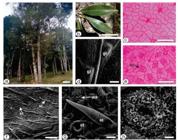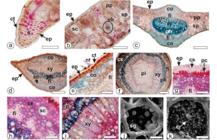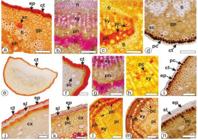Abstract
Ocotea porosa (Nees & Mart.) Barroso, commonly known as “imbuia”, “canela-imbuia” or “imbuia-amarela” in Brazil, is a tree of the Southern Atlantic Forest. The present study investigates the anatomy of leaf and stem, volatile oil chemistry, as well as cytotoxicity and insecticidal activities of the essential oil of O. porosa. Species identification was achieved by anatomy features, mainly due to paracytic and anomocytic stomata; non-glandular trichomes; biconvex midrib and petiole with a collateral open arc vascular bundle; presence of a sclerenchymatous layer, starch grains and crystal sand in the stem; and the presence of phenolic compounds in the epidermis, phloem and xylem of the midrib, petiole and stem. The main volatile components of the essential oil were α-pinene (19.71%), β-pinene (13.86%) and bicyclogermacrene (24.62%). Cytotoxicity against human cancer cell (MCF-7), mouse cancer cell (B16F10) and mouse non-tumoral cell (McCoy) was observed as well as insecticidal activity of the essential oil against susceptible ‘Ft. Dix’ bed bugs (Cimex lectularius L.) by topical application.
Keywords:
anticancer; bed bugs; Cimex lectularius; cytotoxic effect; imbuia; light and scanning electron microscopy

 Thumbnail
Thumbnail
 Thumbnail
Thumbnail
 Thumbnail
Thumbnail
 Thumbnail
Thumbnail
 Thumbnail
Thumbnail




